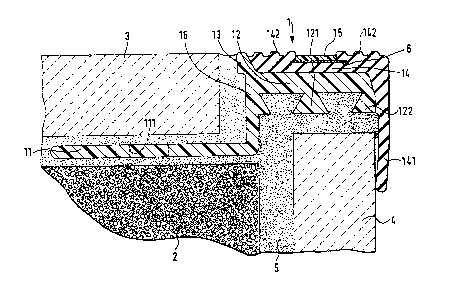Some of the information on this Web page has been provided by external sources. The Government of Canada is not responsible for the accuracy, reliability or currency of the information supplied by external sources. Users wishing to rely upon this information should consult directly with the source of the information. Content provided by external sources is not subject to official languages, privacy and accessibility requirements.
Any discrepancies in the text and image of the Claims and Abstract are due to differing posting times. Text of the Claims and Abstract are posted:
| (12) Patent: | (11) CA 1289722 |
|---|---|
| (21) Application Number: | 1289722 |
| (54) English Title: | CLEAT FOR FINISHING OFF THE CERAMIC TILES ON A STEP |
| (54) French Title: | ELEMENT DE FINITION POUR MARCHES REVETUES DE TUILES CERAMIQUES |
| Status: | Expired and beyond the Period of Reversal |
| (51) International Patent Classification (IPC): |
|
|---|---|
| (72) Inventors : |
|
| (73) Owners : |
|
| (71) Applicants : | |
| (74) Agent: | SMART & BIGGAR LP |
| (74) Associate agent: | |
| (45) Issued: | 1991-10-01 |
| (22) Filed Date: | 1988-01-06 |
| Availability of licence: | N/A |
| Dedicated to the Public: | N/A |
| (25) Language of filing: | English |
| Patent Cooperation Treaty (PCT): | No |
|---|
| (30) Application Priority Data: | ||||||
|---|---|---|---|---|---|---|
|
A CLEAT FOR FINISHING OFF THE CERAMIC TILES ON A STEP
ABSTRACT OF THE DISCLOSURE
There is disclosed a cleat having a Z-shaped cross
section for finishing off the ceramic tiles on a step or the
like, the cleat having a thin fastening leg provided with
breakthroughs and adapted to underlie the ceramic tile on
the step, perpendicular thereto a closing off-leg extending
in front of the tile on the step and perpendicular to the
latter a step-on leg at the edge of the step. The step-on
leg has molded onto its top side a soft elastic cover strip
which covers the cleat which, as a whole, is manufactured in
a single piece from plastic material and which has a lip
downwardly projecting beyond the step-on leg which acts with
prestress against the cleat. A colored insert strip is
embedded in the cover strip in the center in the lengthwise
direction and covered by a transparent plastic strip.
Note: Claims are shown in the official language in which they were submitted.
Note: Descriptions are shown in the official language in which they were submitted.

2024-08-01:As part of the Next Generation Patents (NGP) transition, the Canadian Patents Database (CPD) now contains a more detailed Event History, which replicates the Event Log of our new back-office solution.
Please note that "Inactive:" events refers to events no longer in use in our new back-office solution.
For a clearer understanding of the status of the application/patent presented on this page, the site Disclaimer , as well as the definitions for Patent , Event History , Maintenance Fee and Payment History should be consulted.
| Description | Date |
|---|---|
| Time Limit for Reversal Expired | 2001-10-01 |
| Letter Sent | 2000-10-02 |
| Grant by Issuance | 1991-10-01 |
There is no abandonment history.
| Fee Type | Anniversary Year | Due Date | Paid Date |
|---|---|---|---|
| Reversal of deemed expiry | 1999-10-01 | 1997-08-25 | |
| MF (category 1, 6th anniv.) - small | 1997-10-01 | 1997-08-25 | |
| MF (category 1, 7th anniv.) - small | 1998-10-01 | 1998-09-17 | |
| MF (category 1, 8th anniv.) - small | 1999-10-01 | 1999-08-12 | |
| Reversal of deemed expiry | 1999-10-01 | 1999-08-12 |
Note: Records showing the ownership history in alphabetical order.
| Current Owners on Record |
|---|
| WERNER SCHLUTER |
| Past Owners on Record |
|---|
| None |